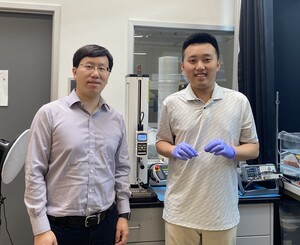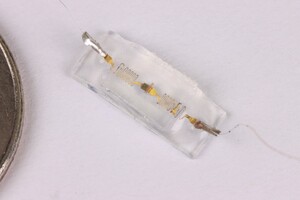Scientists make origami-esque sensors
The sensors allow “soft robots” to perform more complicated tasks.
The sensors allow “soft robots” to perform more complicated tasks.

Scientists from the Viterbi School of Engineering have created a one of a kind strain sensor with an origami-inspired design that allows it to withstand repeated use and take precise measurements.
Strain sensors are used to measure any changes or deformations in what they’re attached to — for example, to track the movements of someone’s hand in VR gaming, or to communicate to a robot how far its hand has moved or its arm has bent. Most current strain sensors are made of a material like rubber or silicone, which does not fare well with repeated use. The new model looks to solve those problems.
Xinghao Huang, the study’s first author and a graduate student studying mechanical engineering, said his background in mechanical engineering led him to research different structures that could be used for the sensor. His research led to origami, which he took inspiration from because of its mutability and ability to maintain its shape.
“We noticed that … you can actually fold and unfold and stretch [origami] to pretty large lengths, and they stay extended,” Huang said. “Also, we noticed that the folding and unfolding [of the origami] was very consistent.”
The team chose a design based on origami’s basic triangle fold, and placed electrodes on either side of the triangle. As the triangle is stretched and compressed, the distance between the electrodes grows and shrinks, which provides the desired data. The distance can be measured both when the sensor is stretched and when it is compressed, an accomplishment other strain sensors have yet to achieve.
“If you compress [the sensor], the folding angle will become smaller and the capacitance will actually increase,” Huang said. “This is a very unique property, because most sensors can only sense large tensile strength, but cannot sense large compressive strength.”
Jonathan Ong, a sophomore majoring in computer engineering and computer science, looked over the study and said he appreciated the scientists’ unique application of origami to engineering.
“It’s really interesting how the origami shape allows it to not deform after a while, like rubber would,” Ong said.

Another of the sensor’s unique attributes is its size: at five-millimeters-by-five-millimeters, it is much more compact than most other sensors, which come in long strips intended for virtual reality. As a result, the sensor has the unique capability of being able to measure very small changes.
One specific application for this technology is in soft robotics. When dealing with rigid robots, it is easy to predict the motion of the robot based on the motion of its joints. But scientists are currently developing soft robots that resemble an elephant’s trunk that wouldn’t have rigid structures, meaning any part of the robot can deform, making it much more difficult to predict its movements.
If Huang’s sensors are arranged on a soft robot, however, they will return very distinct information on how the robot is moving. This information can be used to help scientists gather precise data on the robot’s motions. Eventually, the data may be sent directly back to the robot to give it a sense of itself and its shape to perform more complicated tasks.
The next steps in this research involve making the design more durable and temperature-resistant, as well as developing a way to reconstruct a robot’s entire limb based on data from the strain sensor.
“[The sensor] can tell if the arm is expanding or twisting, but how much is it bent, and can we reconstruct this arm’s shape? The next step is using our sensor data to construct the soft robot’s shape,” Huang said.
Lex Yu, a senior majoring in computer science games, read the study after leading Beyond the Binary through the creation of their own origami. They were impressed by the overall creativity and ingenuity behind Huang’s design.
“It’s a really cool and creative use of technology,” Yu said. “It’s an intersection of art and innovation.”
We are the only independent newspaper here at USC, run at every level by students. That means we aren’t tied down by any other interests but those of readers like you: the students, faculty, staff and South Central residents that together make up the USC community.
Independence is a double-edged sword: We have a unique lens into the University’s actions and policies, and can hold powerful figures accountable when others cannot. But that also means our budget is severely limited. We’re already spread thin as we compensate the writers, photographers, artists, designers and editors whose incredible work you see in our daily paper; as we work to revamp and expand our digital presence, we now have additional staff making podcasts, videos, webpages, our first ever magazine and social media content, who are at risk of being unable to receive the compensation they deserve.
We are therefore indebted to readers like you, who, by supporting us, help keep our paper daily (we are the only remaining college paper on the West Coast that prints every single weekday), independent, free and widely accessible.
Please consider supporting us. Even $1 goes a long way in supporting our work; if you are able, you can also support us with monthly, or even annual, donations. Thank you.
This site uses cookies. By continuing to browse the site, you are agreeing to our use of cookies.
Accept settingsDo Not AcceptWe may request cookies to be set on your device. We use cookies to let us know when you visit our websites, how you interact with us, to enrich your user experience, and to customize your relationship with our website.
Click on the different category headings to find out more. You can also change some of your preferences. Note that blocking some types of cookies may impact your experience on our websites and the services we are able to offer.
These cookies are strictly necessary to provide you with services available through our website and to use some of its features.
Because these cookies are strictly necessary to deliver the website, refusing them will have impact how our site functions. You always can block or delete cookies by changing your browser settings and force blocking all cookies on this website. But this will always prompt you to accept/refuse cookies when revisiting our site.
We fully respect if you want to refuse cookies but to avoid asking you again and again kindly allow us to store a cookie for that. You are free to opt out any time or opt in for other cookies to get a better experience. If you refuse cookies we will remove all set cookies in our domain.
We provide you with a list of stored cookies on your computer in our domain so you can check what we stored. Due to security reasons we are not able to show or modify cookies from other domains. You can check these in your browser security settings.
These cookies collect information that is used either in aggregate form to help us understand how our website is being used or how effective our marketing campaigns are, or to help us customize our website and application for you in order to enhance your experience.
If you do not want that we track your visit to our site you can disable tracking in your browser here:
We also use different external services like Google Webfonts, Google Maps, and external Video providers. Since these providers may collect personal data like your IP address we allow you to block them here. Please be aware that this might heavily reduce the functionality and appearance of our site. Changes will take effect once you reload the page.
Google Webfont Settings:
Google Map Settings:
Google reCaptcha Settings:
Vimeo and Youtube video embeds:
The following cookies are also needed - You can choose if you want to allow them:
